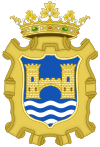Ponferrada
| Ponferrada | ||
|---|---|---|

Facade of the Templar Castle, built in the 12th century
|
||
|
||
| Coordinates: 42°33′N 6°35′W / 42.550°N 6.583°WCoordinates: 42°33′N 6°35′W / 42.550°N 6.583°W | ||
| Country |
|
|
| Region |
|
|
| Province |
|
|
| Comarca |
|
|
| Founded | 11th century | |
| Government | ||
| • Mayor | Gloria Fernández Merayo (PP) | |
| Area | ||
| • Total | 283 km2 (109 sq mi) | |
| Elevation | 544 m (1,785 ft) | |
| Population (2008) | ||
| • Total | 69,769 | |
| • Density | 233.15/km2 (603.9/sq mi) | |
| Time zone | CET (UTC+1) | |
| • Summer (DST) | CEST (UTC+2) | |
| Postal code | 244xx | |
| Area code(s) | 987 | |
| Climate | Csb | |
| Website | www.ponferrada.org | |
Ponferrada (Spanish pronunciation: [pomfeˈraða], from the Latin Pons Ferrata, Iron Bridge) is the capital city of El Bierzo in the Province of León, Spain. It lies on Sil River and it is completely surrounded by mountains. It is the last major town on the French route of the Camino de Santiago before it reaches Santiago de Compostela. In 2008, it had a population of 69,769.
In pre-Roman times the region was populated by the Astures, a Hispano-Celtic Gallaecian people. They were conquered by Emperor Augustus in the Astur-Cantabrian Wars (29-19 BC) and the area quickly became the largest mining center of the Empire during the Roman period, where gold and other metals and minerals were extracted. Numerous Roman mining sites are still visible in the area, one of the most spectacular being Las Médulas, a UNESCO World Heritage Site since 1997. Romans also imported grapevines, and wine production thrived in the region until the propagation of Phylloxera at the end of the 19th century, which destroyed the majority of the vineyards.
The modern name of the city derives from the iron reinforcements added to the ancient bridge over the river Sil (Latin pons for "bridge" and ferrata for "iron"), commissioned by Bishop Osmundo of Astorga to facilitate the crossing of the Sil River to pilgrims in their way to Santiago de Compostela.
...
Wikipedia


